A Novel Comparative Statistical and Experimental Modeling of Pressure Field in Free Jumps along the Apron of USBR Type I and II Dissipation Basins
Abstract
1. Introduction
- Analysis of the minimal and maximal values of pressures along the free jumps within basinI and basinII. These parameters for basinII have not been investigated in the literature.
- Evaluation of the PSD analysis to determine the dominant frequency of fluctuating pressures in the free jumps for basinI and basinII. In addition, assessment of the PDF histograms for the fluctuating pressures at different pressure points and investigation of the skewness and kurtosis coefficients, P*m, extreme pressures (P*min and P*max), σ*X, NK%, and P*K% along basinI and basinII. For reference, we benchmarked and compared our findings with previous similar results of other authors focusing on hydraulic jumps we could retrieve in the present literature.
- Proposition of some new original best-fit relationships to estimate the dimensionless forms of statistical parameters including P*m, σ*X, NK%, and P*K% for the free jumps as a function of the dimensionless position along basinI and basinII.
- Proposition of the hydraulic jump length (Lj) as a scaling factor for the dimensionless position from the toe of the spillway (X*). Marques al. [17] proposed the dimensionless adjustments for the pressure parameters. Due to the presence of significant air bubbles at the beginning of the jump, it is difficult to measure the initial depth of the jump (Y1) with great accuracy. It seems that the expression of Y2−Y1 (conjugated depths of hydraulic jumps) is not appropriate as a scaling factor. In this case, the X* parameter was defined as X/Lj, where Lj is the length of hydraulic jump. In addition, the values of Y1 were calculated using the well-known equation of Bélanger [27].
2. Materials and Methods
2.1. Experimental Setup
2.2. Statistical Parameters
3. Results and Discussion
3.1. Flow Characteristics
3.2. Power Spectral Density Analysis
3.3. Probability Density Function
3.4. Extreme Pressures
3.5. Standard Deviation of Fluctuating Pressures
3.6. Statistical Coefficient of the Probability Distribution
3.7. Estimation of Pressures with Different Probabilities of Occurrence
4. Conclusions
- (i)
- For the first time to our knowledge, our results allow calculation of the statistics and extreme values of the pressure field occurring on the bed of the dissipation basins, and demonstrate the advantage of using a USBR Type II basin in terms of reduced stress over the basin’s bed.
- (ii)
- The Y2 parameter in basinII was decreased against that in basinI. In addition, with increasing flow discharge (Q), supercritical flow depth (Y1) increased more than velocity (V1). As a result, Fr1 reduced with higher Q values.
- (iii)
- The P*min data reached negative values of around −0.2 approximately at X* ≤ 0.2 for basinII, and of −0.4 at X* ≤ 0.3 for basinI (i.e., very close to spillway toe). Therefore, basinII was more reliable than basinI in terms of the possibility of cavitation. More fluctuating values of P*max against the mean values occurred near the spillway, justified by the direct impact of the flow jet on the dissipation basin.
- (iv)
- Analysis of σ*X showed that the dimensionless position of X*σmax is close to 0.20 and 0.29 for basinII and basinI, respectively, with pressure fluctuations decreasing after that. Accordingly, the position of X*σmax was closer to the spillway toe for basinII. With increasing flow discharge, the pressure fluctuations increased. The pressure fluctuations range on the basin bed was visibly narrower for basinII than for basinI. For basinII, σ*Xmax values along the free jumps were reduced by −40% compared to basinI.
- (v)
- Based on the methodologies proposed by Marques et al. [17] and Teixeira [18], new original best-fit adjustments were proposed here for the P*m, σ*X, and NK% parameters to estimate the P*K% parameter in the case of basinI and basinII. In addition, we originally displayed that NK% values show a trend towards a single average value independently of the Froude number, and we proposed an adjustment for NK% as a function of probability.
- (vi)
- Some effort may be devoted to investigating the statistical distribution of pressures on the basin bed. As observed, a deviation of the skewness from the S = 0 value for normal distribution in the beginning area of the basins indicates a different and asymmetric distribution. Positively skewed distributions indicate the potential for more (than normally expected) frequent outbursts of large flow pressure, possibly requiring the increase of the structural resistance of the basin apron.
- (vii)
- The laboratory-scale models presented herein have several limitations that should guide further research on the topic. It should be noted that there is a potential error in scaling the pressure heads. Therefore, just indicating the dimensionless terms may be misleading.
- (viii)
- The results of this work contribute to the present debate about the use of dissipation basins, and especially of USBR Type II ones for spillway flow calming, providing a quantitative assessment of some main features of the hydraulic jump within the dissipation basin, and the modified (reduced) maximum pressure on the basin apron, and are potentially useful for designing dissipation basins in real-world applications.
Author Contributions
Funding
Acknowledgments
Conflicts of Interest
Abbreviation
| B | Basin width (L) |
| basinI | USBR Type I dissipation basin |
| basinII | USBR Type II dissipation basin |
| C′P | Pressure fluctuations intensity coefficient |
| El | Energy head loss along the hydraulic jump (L) |
| Fr1 | Supercritical Froude number |
| Fr2 | Subcritical Froude number |
| g | Gravitational acceleration (LT−2) |
| H | Ogee spillway height |
| K | Kurtosis coefficient |
| LI | Length of basinI (L) |
| LII | Length of basinII (L) |
| Lj | Length of hydraulic jump (L) |
| MAE | Mean absolute error |
| NK% | Statistical coefficient of the probability distribution |
| PK% | Pressure head with a certain probability of occurrence (L) |
| Pmin | Minimum extreme pressure (L) |
| Pm | Mean pressure head at each pressure point (L) |
| Pmax | Maximum extreme pressure (L) |
| PSD | Power spectral density of the pressure data |
| P(X,t) | Instantaneous pressure (L) |
| P*Z | Probability density function (PDF) of the normalized fluctuating pressures |
| P′ | Fluctuating component of pressure (L) |
| Q | Flow discharge (L3T−1) |
| R | Correlation coefficient |
| Re1 | Reynolds number for the supercritical flow of the hydraulic jump |
| RMSE | Root mean squared error |
| S | Skewness coefficient |
| USBR | US Department of the Interior, Bureau of Reclamation |
| V1 | Mean velocity of the coming flow to the dissipation basin (LT−1) |
| V2 | Mean subcritical velocity (LT−1) |
| WI | Willmott’s index of agreement |
| X | Longitudinal position of each point inside the hydraulic jump (L) |
| X* | Dimensionless position of each point (X/Lj) |
| X*d | Characteristic point of the expected flow detachment |
| X*r | Characteristic endpoint of the roller |
| X*j | Characteristic endpoint of the hydraulic jump |
| Y1 | Supercritical flow depth at the jump toe (L) |
| Y2 | Subcritical flow depth at the end of the jump (L) |
| Z | Normalized pressure variable |
| σX | Standard deviation of the pressure fluctuations at point X (L) |
| σ*X | Dimensionless standard deviation of the pressure fluctuations at point X (L) |
| 1 | Supercritical flow |
| 2 | Subcritical flow |
| m | Mean value |
| max | Maximum value |
| min | Minimum value |
| * | Dimensionless value |
References
- Khatsuria, R.M. Hydraulics of Spillways and Energy Dissipators; Marcel Dekker: New York, NY, USA, 2005. [Google Scholar]
- Alves, A.A.M. Characterization of Hydrodynamic Forces in Dissipation Basins under Hydraulic Jumps with Low Froude Number; Universidade Federal do Rio Grande do Sul: Porto Alegre, Brazil, 2008. (In Portuguese) [Google Scholar]
- USBR. Spillways. In Design of Small Dams, 3rd ed.; US Department of the Interior, Bureau of Reclamation: Washington, DC, USA, 1987; pp. 339–437. [Google Scholar]
- Mohamed Ali, H. Effect of roughened-bed stilling basin on length of rectangular hydraulic jump. J. Hydraul. Eng. 1991, 117, 83–93. [Google Scholar] [CrossRef]
- Verma, D.; Goel, A. Stilling basins for pipe outlets using wedge-shaped splitter block. J. Irrig. Drain. Eng. 2000, 126, 179–184. [Google Scholar] [CrossRef]
- Alikhani, A.; Behrozi-Rad, R.; Fathi-Moghadam, M. Hydraulic jump in stilling basin with vertical end sill. Int. J. Phys. Sci. 2010, 5, 25–29. [Google Scholar]
- Tiwari, H.; Goel, A.; Gahlot, V. Experimental Study of effect of end sill on stilling basin performance. Int. J. Eng. Sci. Technol. 2011, 3, 3134–3140. [Google Scholar]
- Cancian Putton, V.; Marson, C.; Fiorotto, V.; Caroni, E. Supercritical flow over a dentated sill. J. Hydraul. Eng. 2011, 137, 1019–1026. [Google Scholar] [CrossRef]
- Tiwari, H.; Goel, A. Effect of end sill in the performance of stilling basin models. Am. J. Civil Eng. Archit. 2014, 2, 60–63. [Google Scholar] [CrossRef]
- Fecarotta, O.; Carravetta, A.; Del Giudice, G.; Padulano, R.; Brasca, A.; Pontillo, M. Experimental results on the physical model of an USBR type II stilling basin. In Proceedings of the River Flow 2016, International Conference on Fluvial Hydraulics, St. Louis, MI, USA, 10–14 July 2016. [Google Scholar]
- Chanson, H.; Carvalho, R. Hydraulic jumps and stilling basins. In Energy Dissipation in Hydraulic Structures; Chanson, H., Ed.; CRC Press: Leiden, The Netherlands, 2015; pp. 65–104. [Google Scholar]
- Vischer, D.; Hager, W.H. Dam Hydraulics; Wiley: Ürich, Switzerland, 1998; Volume 2. [Google Scholar]
- Padulano, R.; Fecarotta, O.; Del Giudice, G.; Carravetta, A. Hydraulic design of a USBR Type II stilling basin. J. Irrig. Drain. Eng. 2017, 143, 1–9. [Google Scholar] [CrossRef]
- Toso, J.W.; Bowers, C.E. Extreme pressures in hydraulic-jump stilling basins. J. Hydraul. Eng. 1988, 114, 829–843. [Google Scholar] [CrossRef]
- Endres, L.A.M. Contribution to the Development of a System for the Acquisition and Processing of Instantaneous Pressures Data in the Laboratory; Federal University of Rio Grande do Sul: Porto Alegre, Brazil, 1990. (In Portuguese) [Google Scholar]
- Pinheiro, A.A.d.N. Hydrodynamic Actions in Thresholds for Energy Dissipation Basin by Hydraulic Jumps; Universidade Técnica de Lisboa: Lisbon, Portugal, 1995. (In Portuguese) [Google Scholar]
- Marques, M.G.; Drapeau, J.; Verrette, J.-L. Pressure fluctuation coefficient in a hydraulic jump. Braz. J. Water Resour. (Rbrh) 1997, 2, 45–52. (In Portuguese) [Google Scholar]
- Teixeira, E.D. Scale Effect on Estimating Extreme Pressure Values on the Bed of the Hydraulic Dissipation Basins; Universidade Federal do Rio Grande do Sul: Porto Alegre, Brazil, 2008. (In Portuguese) [Google Scholar]
- Farhoudi, J.; Sadat-Helbar, S.; Aziz, N.I. Pressure fluctuation around chute blocks of SAF stilling basins. J. Agric. Sci. Technol. 2010, 12, 203–212. [Google Scholar]
- Novakoski, C.K.; Hampe, R.F.; Conterato, E.; Marques, M.G.; Teixeira, E.D. Longitudinal distribution of extreme pressures in a hydraulic jump downstream of a stepped spillway. Braz. J. Water Resour. (Rbrh) 2017, 22. [Google Scholar] [CrossRef][Green Version]
- Macián-Pérez, J.F.; García-Bartual, R.; Huber, B.; Bayon, A.; Vallés-Morán, F.J. Analysis of the flow in a typified USBR II stilling basin through a numerical and physical modeling approach. Water 2020, 12, 227. [Google Scholar] [CrossRef]
- Hampe, R.F.; Steinke Júnior, R.; Prá, M.D.; Marques, M.G.; Teixeira, E.D. Extreme pressure forecasting methodology for the hydraulic jump downstream of a low head spillway. Braz. J. Water Resour. (Rbrh) 2020, 25, 1–10. [Google Scholar] [CrossRef]
- Samadi, M.; Sarkardeh, H.; Jabbari, E. Explicit data-driven models for prediction of pressure fluctuations occur during turbulent flows on sloping channels. Stoch. Environ. Res. Risk Assess. 2020, 34, 691–707. [Google Scholar] [CrossRef]
- Mousavi, S.N.; Farsadizadeh, D.; Salmasi, F.; Dalir, A.H.; Bocchiola, D. Analysis of minimal and maximal pressures, uncertainty and spectral density of fluctuating pressures beneath classical hydraulic jumps. Water Supply 2020, 20, 1909–1921. [Google Scholar] [CrossRef]
- Mousavi, S.N.; Júnior, R.S.; Teixeira, E.D.; Bocchiola, D.; Nabipour, N.; Mosavi, A.; Shamshirband, S. Predictive modeling the free hydraulic jumps pressure through advanced statistical methods. Mathematics 2020, 8, 323. [Google Scholar] [CrossRef]
- Mousavi, S.N.; Farsadizadeh, D.; Salmasi, F.; Hosseinzadeh Dalir, A. Evaluation of pressure fluctuations coefficient along the USBR Type II stilling basin using experimental results and AI models. ISH J. Hydraul. Eng. 2020. [Google Scholar] [CrossRef]
- Belanger, J.B. Essay on the Numerical Solution of Some Problems Related to the Constant Motion of Water Flow; Carilian-Goeury: Paris, France, 1828. (In French) [Google Scholar]
- Hager, W.H.; Li, D. Sill-controlled energy dissipator. J. Hydraul. Res. 1992, 30, 165–181. [Google Scholar] [CrossRef]
- Chaudhry, M.H. Open-Channel Flow, 2nd ed.; Springer Science & Business Media: New York, NY, USA, 2008. [Google Scholar]
- Chanson, H. Development of the Bélanger equation and backwater equation by Jean-Baptiste Bélanger (1828). J. Hydraul. Eng. 2009, 135, 159–163. [Google Scholar] [CrossRef]
- Bennett, N.D.; Croke, B.F.; Guariso, G.; Guillaume, J.H.; Hamilton, S.H.; Jakeman, A.J.; Marsili-Libelli, S.; Newham, L.T.; Norton, J.P.; Perrin, C. Characterising performance of environmental models. Environ. Model. Softw. 2013, 40, 1–20. [Google Scholar] [CrossRef]
- Willmott, C.J.; Matsuura, K. Advantages of the mean absolute error (MAE) over the root mean square error (RMSE) in assessing average model performance. Clim. Res. 2005, 30, 79–82. [Google Scholar] [CrossRef]
- Chai, T.; Draxler, R.R. Root mean square error (RMSE) or mean absolute error (MAE)?–Arguments against avoiding RMSE in the literature. Geosci. Model Dev. 2014, 7, 1247–1250. [Google Scholar] [CrossRef]
- Willmott, C.J.; Robeson, S.M.; Matsuura, K. A refined index of model performance. Int. J. Climatol. 2012, 32, 2088–2094. [Google Scholar] [CrossRef]
- Fiorotto, V.; Rinaldo, A. Turbulent pressure fluctuations under hydraulic jumps. J. Hydraul. Res. 1992, 30, 499–520. [Google Scholar] [CrossRef]
- Sharma, C.; Ojha, C. Statistical parameters of hydrometeorological variables: Standard deviation, SNR, skewness and kurtosis. In Advances in Water Resources Engineering and Management; Springer: Singapore, 2020; Volume 39, pp. 59–70. [Google Scholar]
- Novakoski, C.K.; Conterato, E.; Marques, M.; Teixeira, E.D.; Lima, G.A.; Mees, A. Macro-turbulent characteristcs of pressures in hydraulic jump formed downstream of a stepped spillway. Braz. J. Water Resour. (Rbrh) 2017, 22. [Google Scholar] [CrossRef]
- Prá, M.D.; Priebe, P.d.S.; Teixeira, E.D.; Marques, M.G. Evaluation of pressure fluctuation in hydraulic jump by dissociation of hydraulic forces. Braz. J. Water Resour. (Rbrh) 2016, 21, 221–231. (In Portuguese) [Google Scholar]
- Yan, Z.-M.; Zhou, C.-T.; Lu, S.-Q. Pressure fluctuations beneath spatial hydraulic jumps. J. Hydrodyn. 2006, 18, 723–726. [Google Scholar] [CrossRef]
- Pei-Qing, L.; Ai-Hua, L. Model discussion of pressure fluctuations propagation within lining slab joints in stilling basins. J. Hydraul. Eng. 2007, 133, 618–624. [Google Scholar] [CrossRef]
- Wiest, R.A. Evaluation of the Pressure Field in Hydraulic Jump Formed Downstream of a Spillway with Different Submergence Degrees; Universidade Federal do Rio Grande do Sul: Porto Alegre, Brazil, 2008. (In Portuguese) [Google Scholar]

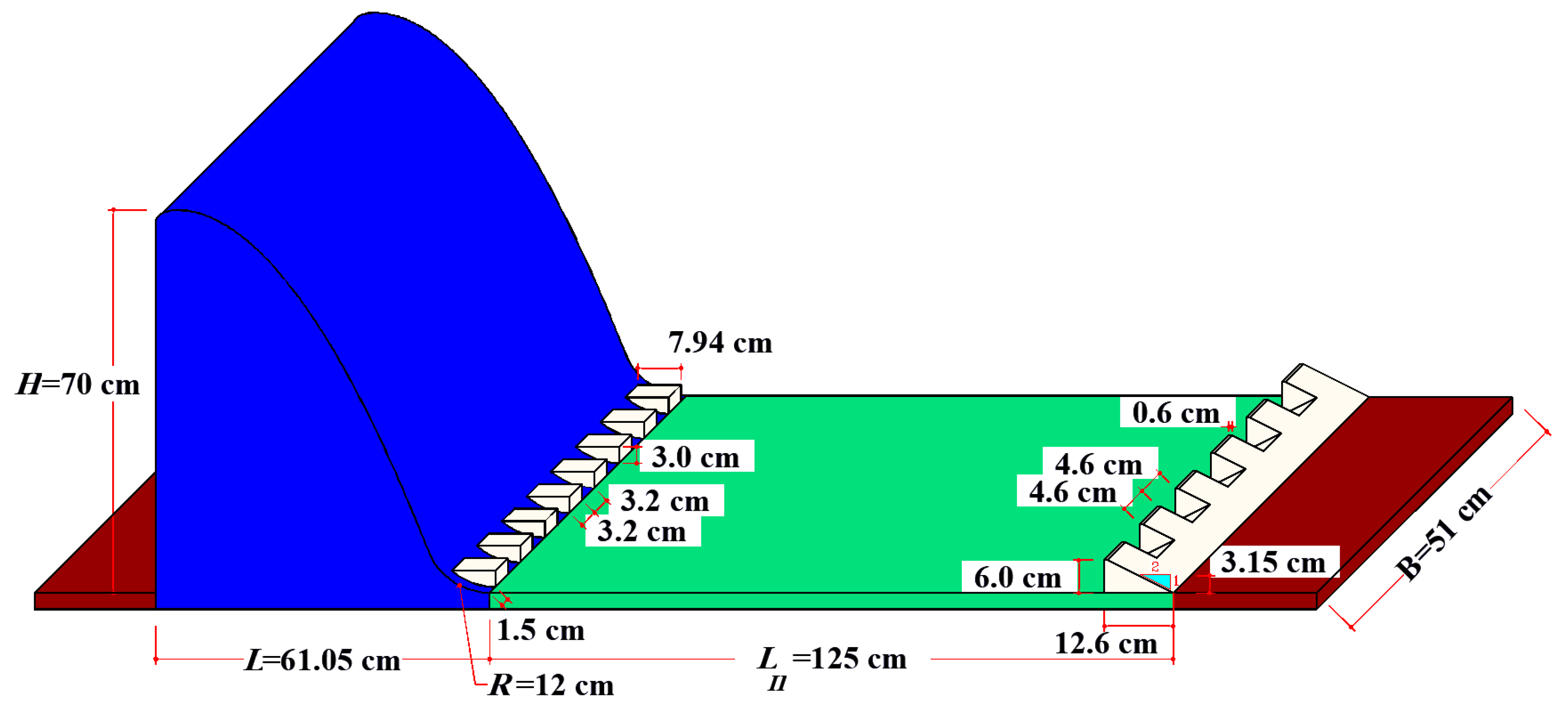

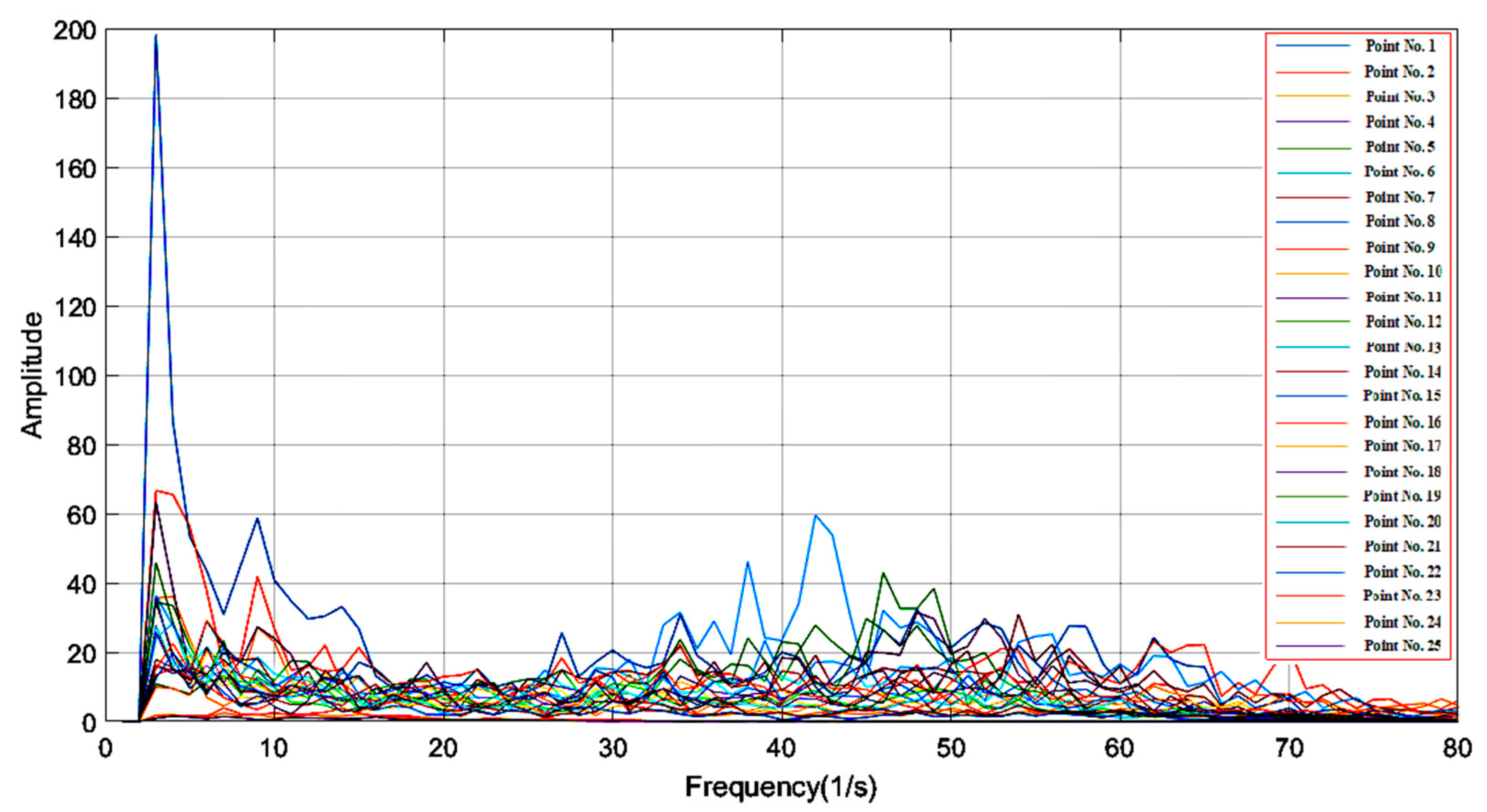

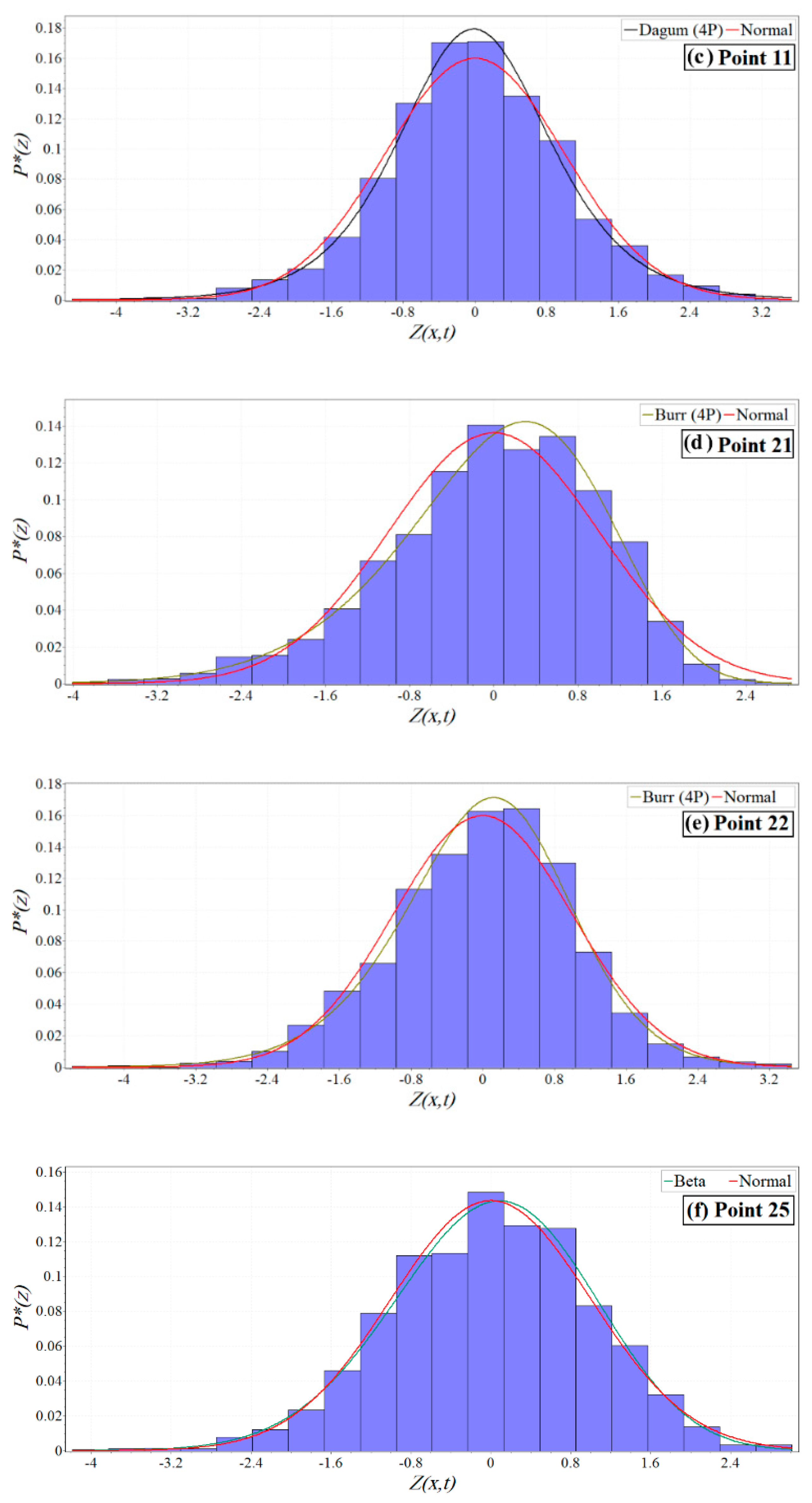
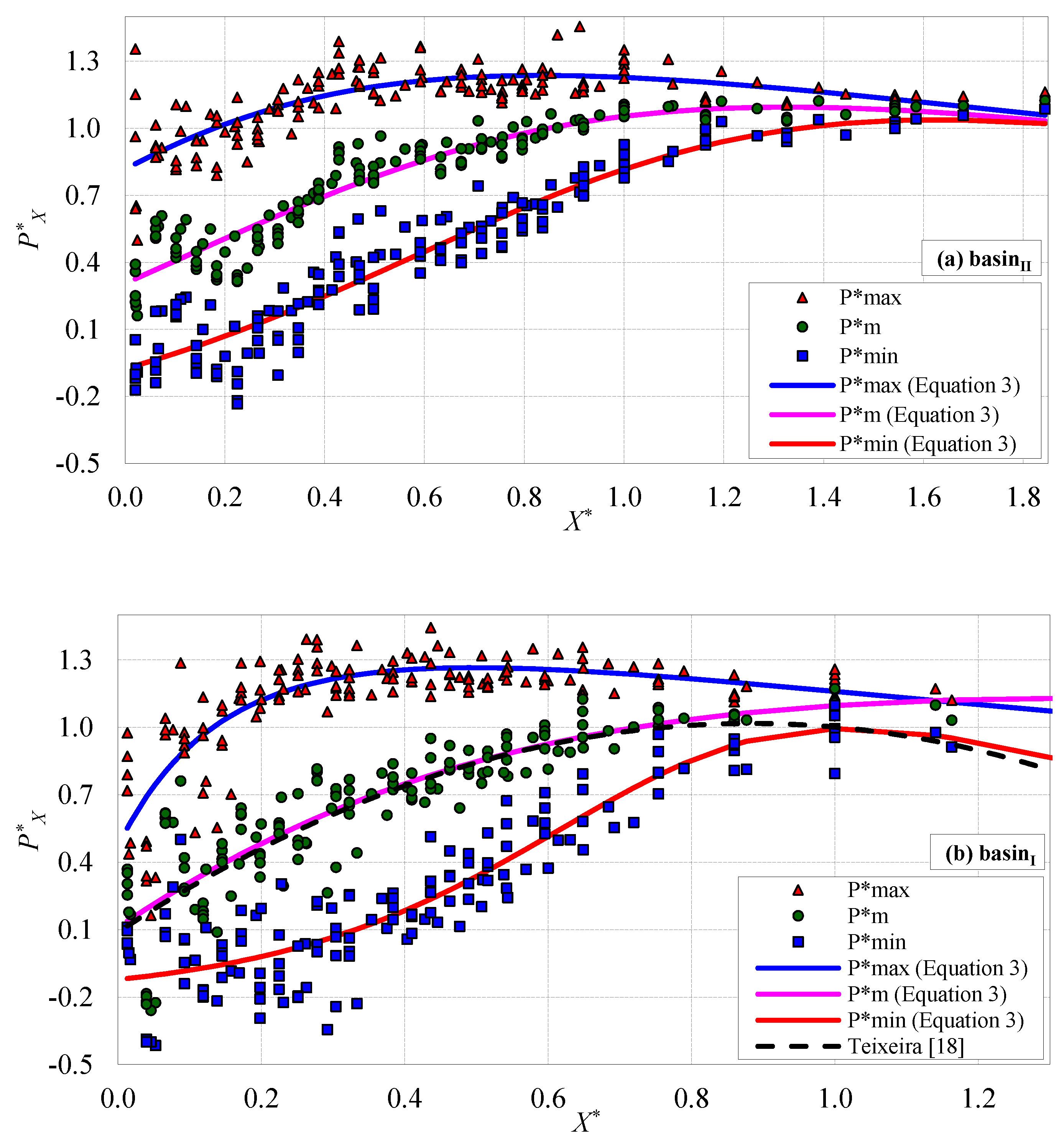
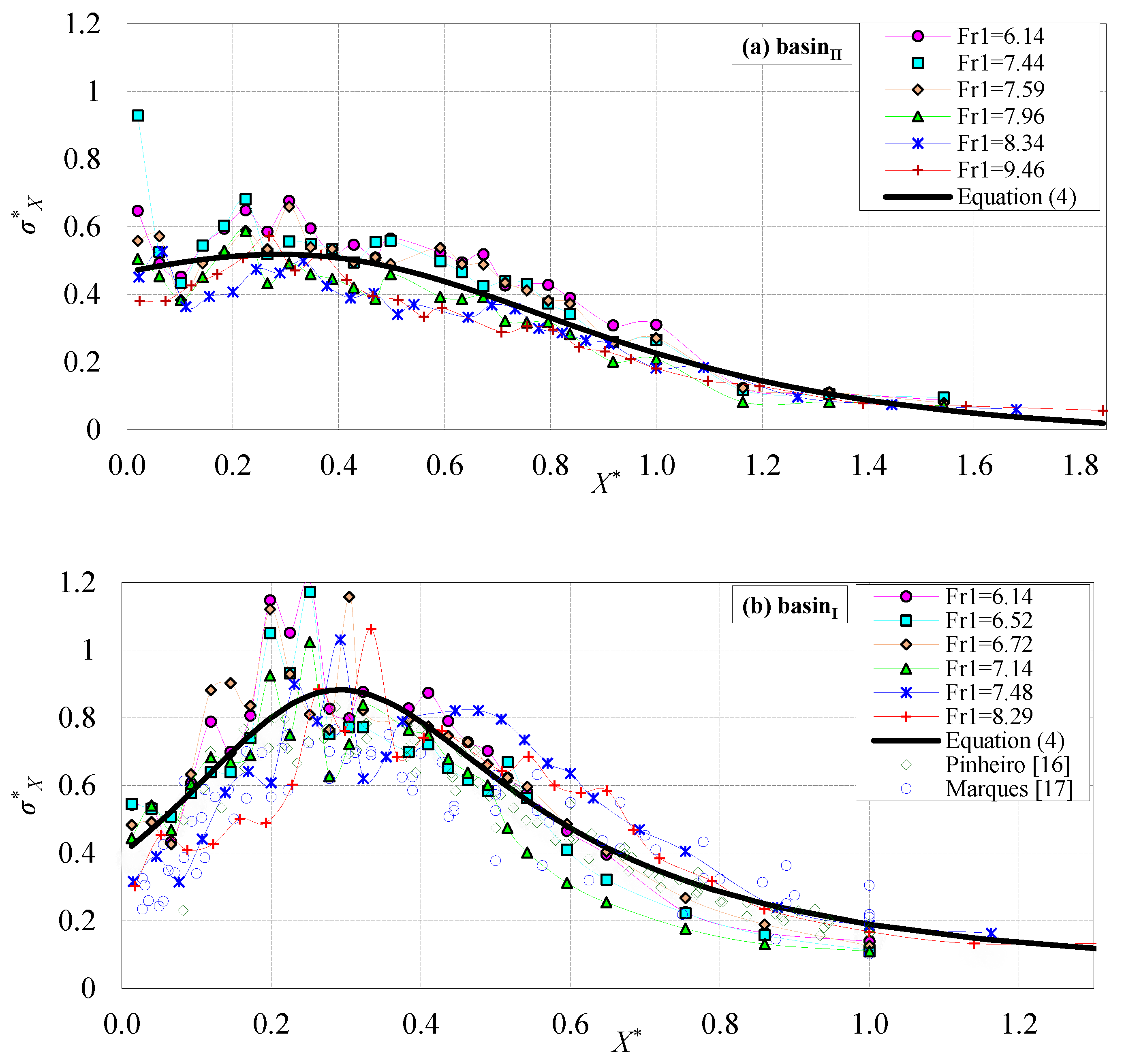

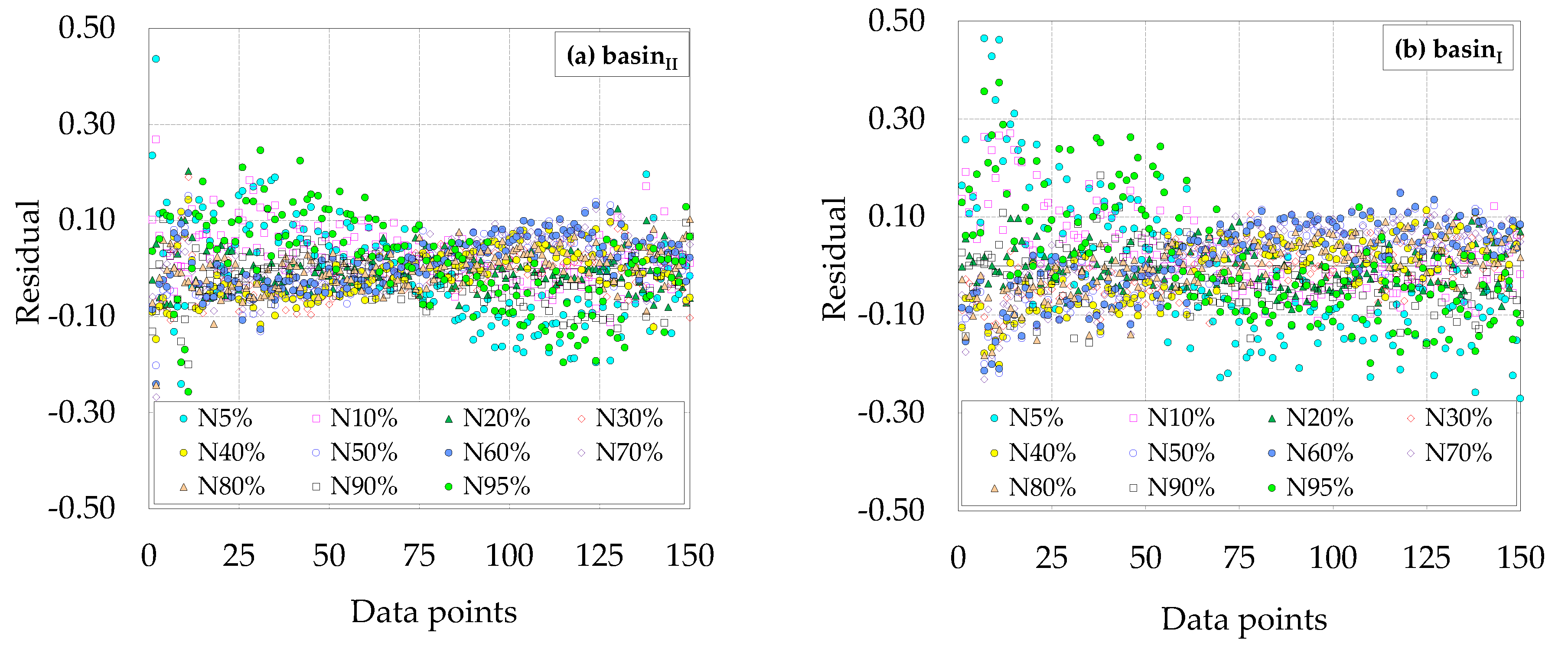
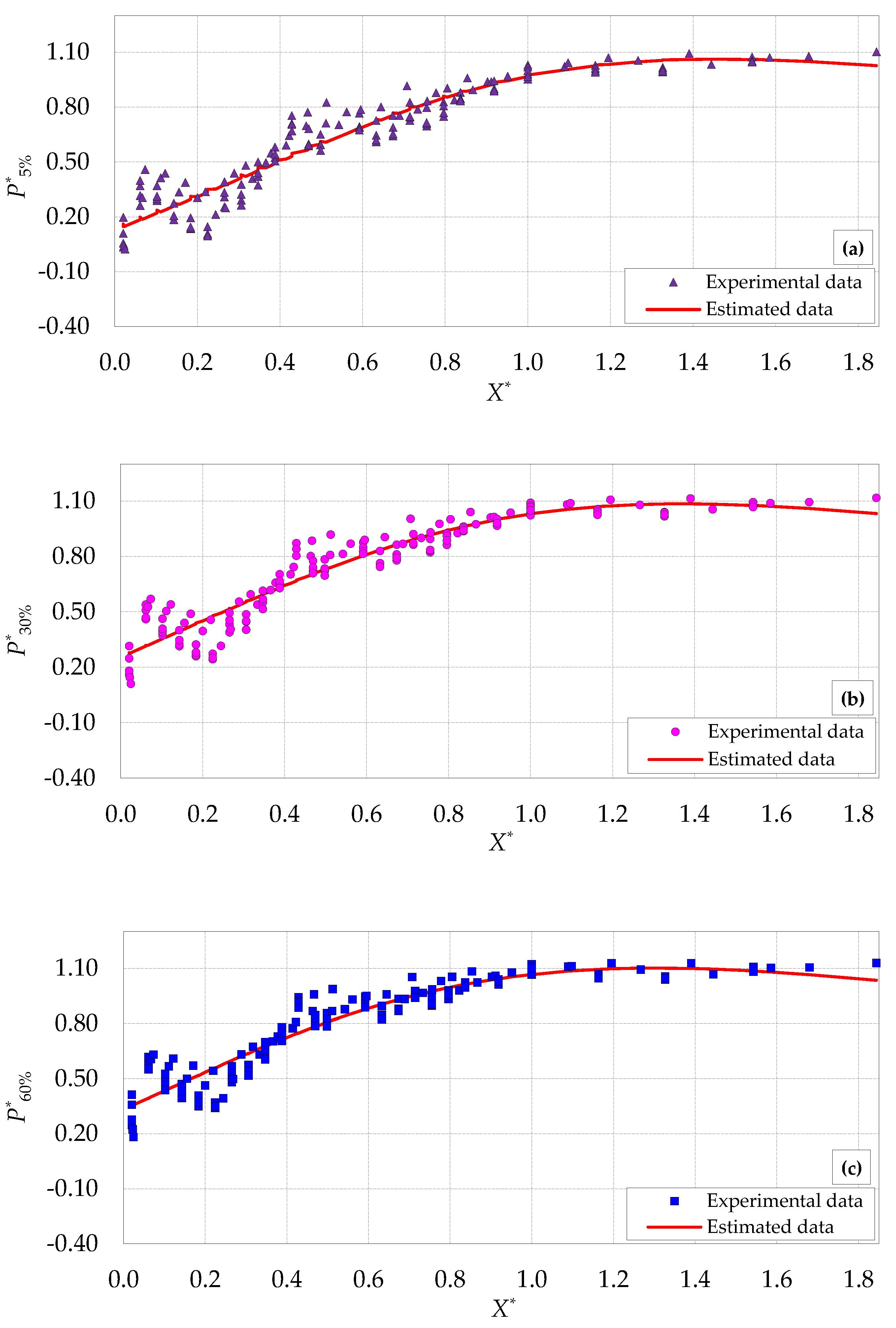
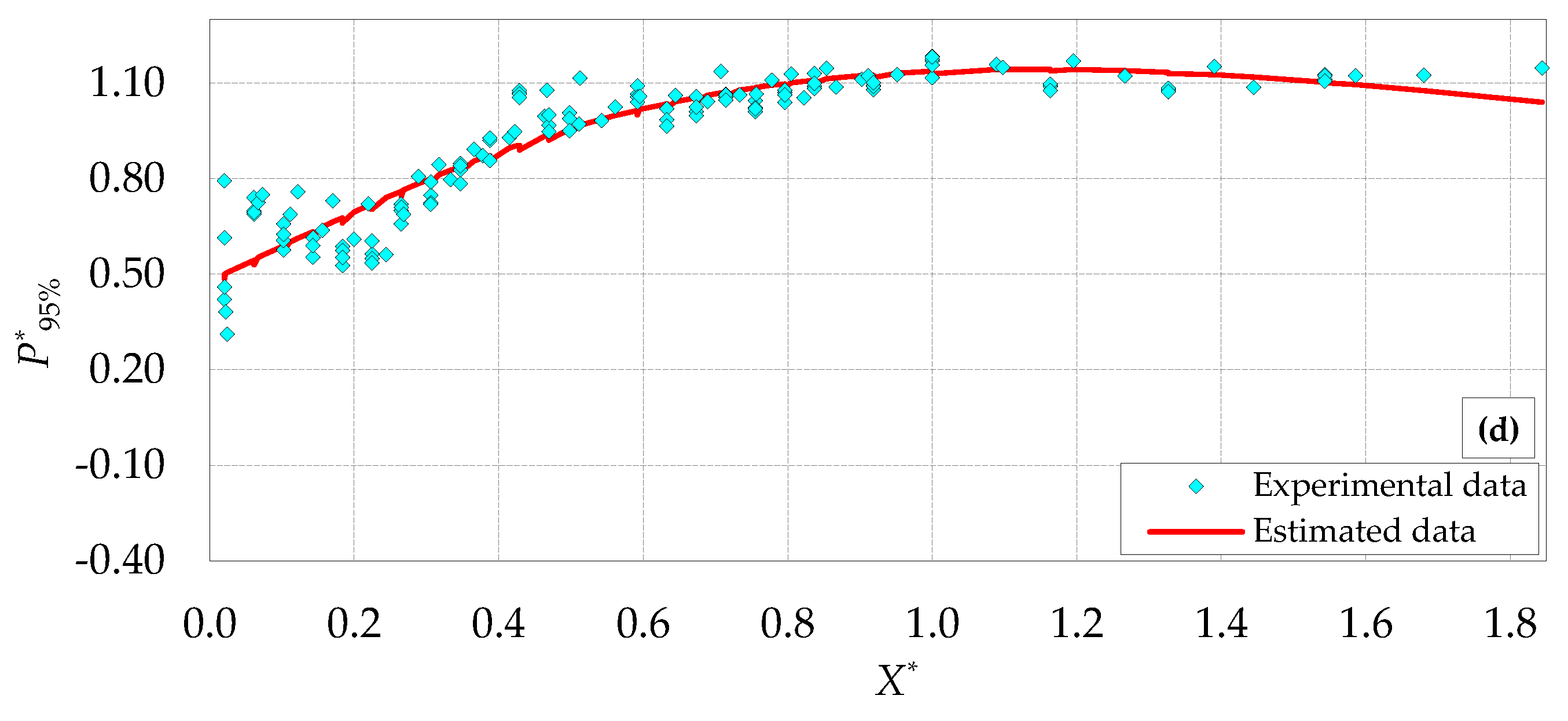
| Q (L/s) | V1 (m/s) | Fr1 | Re1 | Y1 (cm) | Y2 (cm) | Lj (cm) | ||
|---|---|---|---|---|---|---|---|---|
| basinI | basinII | basinI | basinII | |||||
| 33.0 | 3.52 | 8.29 | 58,200 | 1.84 | 20.65 | 19.69 | 142.50 | 102.50 |
| 43.0 | 3.59 | 7.48 | 74,400 | 2.35 | 23.70 | 22.44 | 162.50 | 112.50 |
| 47.5 | 3.60 | 7.14 | 81,500 | 2.59 | 24.87 | 23.57 | 189.00 | 122.50 |
| 52.7 | 3.58 | 6.72 | 89,500 | 2.89 | 26.05 | 24.70 | 189.00 | 122.50 |
| 55.0 | 3.56 | 6.52 | 92,900 | 3.03 | 26.49 | 25.33 | 189.00 | 122.50 |
| 60.4 | 3.53 | 6.14 | 100,900 | 3.36 | 27.55 | 26.60 | 189.00 | 122.50 |
| Basin | P*X | A | B | γ | δ | R | RMSE | MAE |
|---|---|---|---|---|---|---|---|---|
| basinII | P*min | −0.0758 | 0.6885 | −0.6537 | 0.4041 | 0.950 | 0.110 | 0.082 |
| P*m | 0.3057 | 0.9186 | −0.2466 | 0.4086 | 0.944 | 0.085 | 0.063 | |
| P*max | 0.8171 | 1.5498 | 0.4397 | 0.4879 | 0.753 | 0.100 | 0.072 | |
| basinI | P*min | −0.1220 | 0.5397 | −1.6625 | 1.0825 | 0.909 | 0.155 | 0.122 |
| P*m | 0.1094 | 2.2112 | 0.6233 | 0.4925 | 0.882 | 0.150 | 0.105 | |
| P*max | 0.4690 | 8.5806 | 4.2451 | 2.5554 | 0.789 | 0.145 | 0.099 |
| Results | σ*X max | X*σmax |
|---|---|---|
| basinII | 0.50~0.68 | 0.07~0.33 |
| basinI [25] | 1.02~1.20 | 0.25~0.33 |
| Endres [15] | 0.65~0.77 | 0.03~0.18 |
| Pinheiro [16] | 0.73~0.83 | 0.25~0.33 |
| Marques [17] | 0.69~0.76 | 0.22~0.40 |
| Results | a | B | c | d | R | RMSE | MAE |
|---|---|---|---|---|---|---|---|
| basinII | 0.4661 | −0.2218 | −1.1229 | 1.2068 | 0.910 | 0.065 | 0.053 |
| basinI | 0.3975 | 0.3735 | −3.3347 | 6.4248 | 0.872 | 0.120 | 0.095 |
| NK% | N5% | N10% | N20% | N30% | N40% | N50% | N60% | N70% | N80% | N90% | N95% |
|---|---|---|---|---|---|---|---|---|---|---|---|
| basinII | −1.66 | −1.25 | −0.80 | −0.48 | −0.22 | 0.02 | 0.252 | 0.51 | 0.80 | 1.23 | 1.60 |
| basinI | −1.62 | −1.25 | −0.82 | −0.50 | −0.24 | 0.00 | 0.242 | 0.50 | 0.81 | 1.25 | 1.63 |
| Results | α | β | γ | δ |
|---|---|---|---|---|
| basinII | −2.1625 | 4.3873 | 3.8320 | −3.7389 |
| basinI | −2.0752 | 4.1402 | 3.3326 | −3.3448 |
| P*K% | basinII | basinI | ||||||
|---|---|---|---|---|---|---|---|---|
| R | RMSE | MAE | WI | R | RMSE | MAE | WI | |
| P*5% | 0.948 | 0.096 | 0.073 | 0.973 | 0.880 | 0.166 | 0.122 | 0.934 |
| P*10% | 0.946 | 0.094 | 0.071 | 0.972 | 0.879 | 0.164 | 0.120 | 0.933 |
| P*20% | 0.944 | 0.092 | 0.069 | 0.971 | 0.879 | 0.161 | 0.116 | 0.932 |
| P*30% | 0.944 | 0.090 | 0.067 | 0.970 | 0.880 | 0.158 | 0.112 | 0.932 |
| P*40% | 0.943 | 0.088 | 0.065 | 0.970 | 0.882 | 0.155 | 0.109 | 0.933 |
| P*50% | 0.943 | 0.087 | 0.063 | 0.970 | 0.884 | 0.152 | 0.106 | 0.934 |
| P*60% | 0.940 | 0.085 | 0.062 | 0.969 | 0.884 | 0.150 | 0.103 | 0.934 |
| P*70% | 0.942 | 0.082 | 0.060 | 0.969 | 0.884 | 0.147 | 0.100 | 0.934 |
| P*80% | 0.941 | 0.080 | 0.059 | 0.969 | 0.884 | 0.145 | 0.097 | 0.934 |
| P*90% | 0.939 | 0.077 | 0.057 | 0.968 | 0.881 | 0.141 | 0.093 | 0.934 |
| P*95% | 0.929 | 0.078 | 0.057 | 0.963 | 0.848 | 0.138 | 0.093 | 0.933 |
Publisher’s Note: MDPI stays neutral with regard to jurisdictional claims in published maps and institutional affiliations. |
© 2020 by the authors. Licensee MDPI, Basel, Switzerland. This article is an open access article distributed under the terms and conditions of the Creative Commons Attribution (CC BY) license (http://creativecommons.org/licenses/by/4.0/).
Share and Cite
Mousavi, S.N.; Bocchiola, D. A Novel Comparative Statistical and Experimental Modeling of Pressure Field in Free Jumps along the Apron of USBR Type I and II Dissipation Basins. Mathematics 2020, 8, 2155. https://doi.org/10.3390/math8122155
Mousavi SN, Bocchiola D. A Novel Comparative Statistical and Experimental Modeling of Pressure Field in Free Jumps along the Apron of USBR Type I and II Dissipation Basins. Mathematics. 2020; 8(12):2155. https://doi.org/10.3390/math8122155
Chicago/Turabian StyleMousavi, Seyed Nasrollah, and Daniele Bocchiola. 2020. "A Novel Comparative Statistical and Experimental Modeling of Pressure Field in Free Jumps along the Apron of USBR Type I and II Dissipation Basins" Mathematics 8, no. 12: 2155. https://doi.org/10.3390/math8122155
APA StyleMousavi, S. N., & Bocchiola, D. (2020). A Novel Comparative Statistical and Experimental Modeling of Pressure Field in Free Jumps along the Apron of USBR Type I and II Dissipation Basins. Mathematics, 8(12), 2155. https://doi.org/10.3390/math8122155






